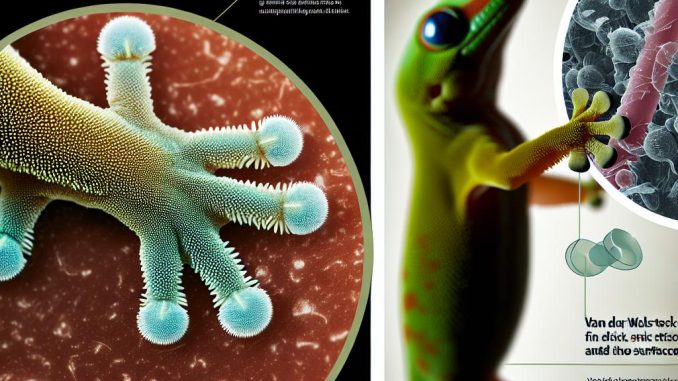
The Secret Behind Gecko Adhesion
Geckos are small lizards widely known for their remarkable ability to scale walls and even walk across ceilings. This incredible skill is due to their uniquely designed feet, which have been the subject of extensive scientific research. Understanding the mechanism behind this phenomenon not only satisfies biological curiosity but also has potential applications in developing advanced adhesive technologies.
The Structure of Gecko Feet
Geckos possess a fascinating biological structure within their feet that allows them to achieve adhesion on virtually any surface. Their feet are covered in millions of tiny hair-like structures known as setae. These setae further break down into hundreds of even smaller structures called spatulae. The dimensions of these spatulae are so minute that they can interact at a molecular level with outer surfaces, which is the secret behind their extraordinary adhesive qualities.
The architecture of gecko feet serves as a perfect example of evolution’s artistry in creating specialized biological adaptations. The formation and distribution of setae and spatulae result in maximizing surface contact, which plays an essential role in their sticking capability.
The Role of Van der Waals Forces
Critical to the understanding of gecko adhesion is the role of Van der Waals forces. These forces are weak, short-range electrical attractions that occur between molecules, manifesting when they are very close to each other. Although each spatula generates only tiny Van der Waals forces, the combined effect of millions of spatulae is sufficient to hold a gecko’s weight, even when it hangs vertically or upside down.
What’s intriguing is that these forces enable geckos to stick to surfaces without using any secreted substance like glue or suction cups. This adhesive ability operates purely through physical interactions at the molecular level, a principle that has significant implications for how we design synthetic adhesive materials.
The Self-Cleaning Mechanism of Gecko Feet
Equally fascinating is the gecko’s self-cleaning ability, which ensures that dust and dirt do not compromise their adhesion over time. When geckos move their feet, the varying angle and pressure create conditions that naturally expel these particles. This self-cleaning feature also highlights the efficiency of the foot’s structural design, which is proficient in removing debris while retaining adhesive capabilities without needing any maintenance or external input.
This self-cleaning property mirrors some similar qualities found in other natural materials, indicating a potential direction for developing self-cleaning synthetic adhesives which might find use in various industrial and consumer applications.
Adaptation and Versatility on Various Surfaces
Geckos exhibit an extraordinary capacity to adhere to a wide range of surfaces, be they smooth or textured. The flexible nature of their setae means they can dynamically adjust to different surface contours, thereby maximizing the area of contact and enhancing adhesion. Studies have shown that geckos can efficiently and rapidly detach their feet for swift locomotion, highlighting their ability to engage and disengage surfaces with minimal effort.
The adaptability of their adhesive system enables geckos to traverse diverse environments with agility and ease. This adaptability presents opportunities for developing synthetic systems that can operate effectively in various conditions, enhancing their value in real-world applications.
Potential Applications in Technology
Research into gecko adhesion inspires a new frontier in materials science, where the biological principles derived from gecko feet are being used to innovate new materials and technologies. Engineers and scientists are actively developing synthetic adhesives that closely mimic the mechanisms found in gecko feet, paving the way for new products with enhanced adhesive properties.
In robotics, for instance, these principles are instrumental in creating climbing robots that can maneuver over complex terrains with ease, a boon for search and rescue missions or infrastructure inspections. In medical technology, gecko-inspired adhesives are shaping the design of skin-friendly bandages and medical tapes that secure without harm or discomfort, minimizing interruptions to skin integrity.
The examination and application of gecko adhesion mechanisms underscore the broader scope of biomimicry, a field where natural systems become the blueprint for human innovation. By adopting nature’s designs, we can develop technologies that are both efficient and environmentally friendly.
Further Reading and Research
For those interested in expanding their understanding of gecko adhesion and its technological applications, there exists a wealth of resources in scientific literature and journals. These publications, including those from reputable science and technology organizations, offer updated research findings and insights into ongoing advancements in this field.
Such resources not only provide in-depth knowledge but also present case studies and interviews with leading researchers, adding context to theoretical findings. Engaging with scientific articles can inspire further inquiry and innovation, bridging the gap between natural phenomena and human technological advancement.
Additional exploration into this fascinating topic is an invitation not only to understand a unique biological adaptation but also to appreciate the potential avenues it opens for technological progress. By continuing to study and harness gecko adhesion mechanisms, we stand on the cusp of exciting developments across multiple scientific and engineering domains.
